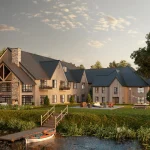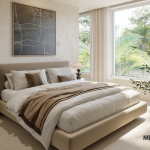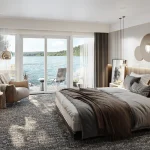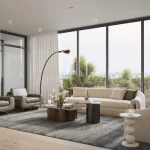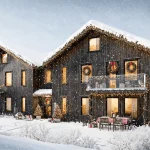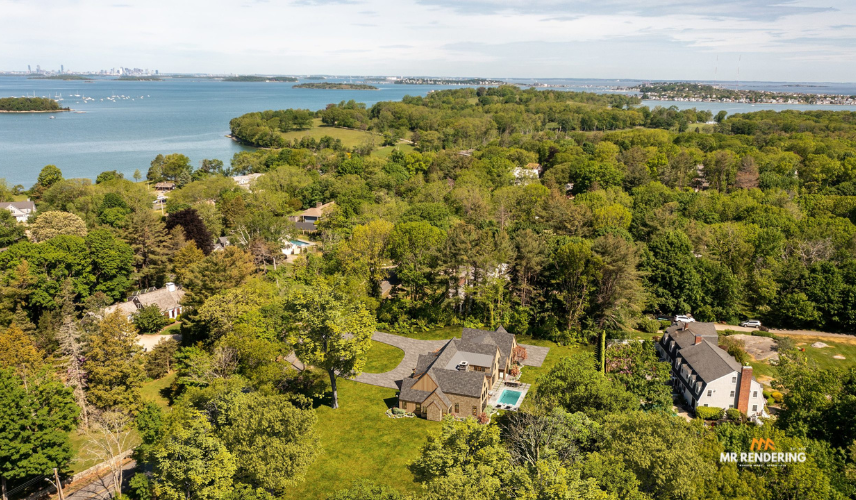
Photomontage architecture directly addresses the core challenge every architect faces: helping clients, planning committees, and stakeholders truly visualize how a proposed building will look and feel within its actual, real-world environment. While stunning standalone 3D renderings showcase design excellence, they often lack the crucial context of the existing streetscape or neighborhood.
This is where photomontage architecture transforms the conversation. It’s a sophisticated technique that seamlessly integrates your detailed, computer-generated 3D architectural models directly into high-quality photographs of the real-world location. Unlike pure CGI which creates an entirely digital scene, photomontage architecture leverages the authenticity of actual site photos, digitally inserting your proposed design to create a powerful hybrid visualization that offers unparalleled clarity and immediate understanding for evaluation and approval.
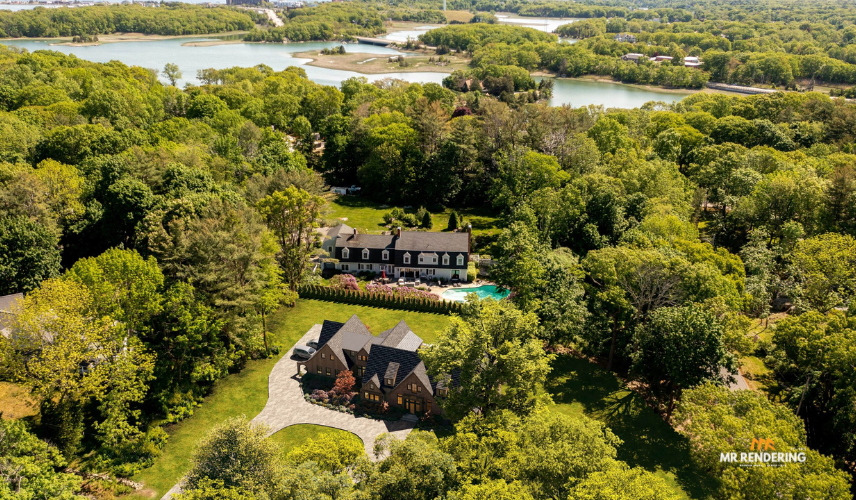
Aerial Photomontage of Wooded Coastal Properties
Understanding the Power of Architectural Photomontage
At its core, architectural photomontage represents the evolution of visualization technology meeting practical necessity. Historically, architects created collages by hand, cutting and pasting printed renders onto photographs. Today’s digital photomontage leverages advanced 3D modeling software, precise camera matching technology, and sophisticated compositing techniques to achieve photorealistic results that are nearly indistinguishable from actual photographs.
What sets photomontage apart from traditional 3D rendering is the authenticity of context. When you place a new residential tower into a photograph of an actual city block, viewers see exactly how the building relates to neighboring structures, how it affects sightlines, and how it integrates with the existing urban fabric. This level of realism is difficult and expensive to achieve with pure CGI, which would require modeling every surrounding building, tree, car, and street element.
The applications for photomontage architecture are extensive and impactful. Planning permission submissions benefit enormously from photomontages, as they allow planning committees and community members to assess visual impact accurately. Real estate developers use photomontages in marketing materials to show prospective buyers or tenants exactly what they’re investing in. Urban planners rely on photomontages to communicate master plan visions to diverse stakeholders who may lack the technical background to interpret traditional architectural drawings.
The Strategic Benefits of Choosing Photomontage
One of the most compelling advantages of architectural photomontage is the accelerated stakeholder buy-in it produces. When community members attend public consultations and see photomontages showing a proposed development in their actual neighborhood—from the exact street corners they walk past daily—the feedback becomes more informed and constructive. This transparency builds trust and reduces opposition based on misunderstanding or imagination running wild about potential impacts.
A significant advantage, particularly when partnering with a skilled offshore studio, is the exceptional value offered by photomontage. Building a complete CGI scene matching an existing location requires extensive, costly modeling of every contextual element. Photomontage architecture cleverly bypasses this by using real site photography as the backdrop, concentrating the creative effort and rendering power solely on your architectural design. As an offshore specialist, MR Rendering Studio leverages this efficiency alongside our access to a deep pool of talent and streamlined processes. This unique combination allows us to deliver premium-quality, highly realistic photomontages architecture at a price point that offers maximum impact for your budget, far more competitively than many onshore alternatives.
|Explore how to choose the best offshore 3D rendering partnership without scaling your in-house team
The timeline advantages matter tremendously in fast-paced development cycles. While comprehensive CGI scenes might require weeks of modeling existing context, photomontage architecture projects can often be completed in days once site photography is secured. This speed enables architects to respond quickly to design revisions, explore multiple massing options, or prepare time-sensitive planning submissions without sacrificing visual quality.
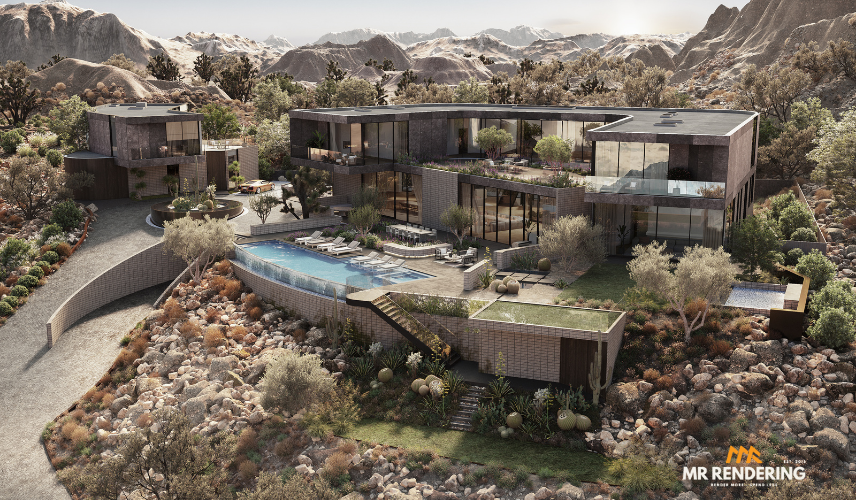
Luxury Desert Estate with Infinity Pool in Los Angeles – 3D Rendering Los Angeles project
Mastering the Photomontage Creation Process
Creating convincing architectural photomontage requires meticulous attention to technical and artistic details. The process begins with site photography, which is far more critical than simply taking snapshots. Professional photomontage requires high-resolution images captured with known camera specifications, from multiple angles and viewpoints that correspond to key viewing locations identified in planning requirements or marketing strategies.
Camera matching represents the technical foundation of successful photomontage architecture. Using the photograph’s metadata and identifiable reference points in the image, visualization specialists reconstruct the exact camera position, focal length, and angle within 3D software. This ensures that the rendered building’s perspective matches the photograph perfectly—misalignment here creates immediately obvious visual discord that undermines credibility.
Lighting calibration demands careful analysis of the photograph’s lighting conditions. The 3D model must be lit to match the time of day, weather conditions, and light quality visible in the base photograph. Sun angle, shadow direction, cloud cover, and ambient light color all need replication in the 3D scene. Advanced techniques include analyzing shadow edges in the photograph to determine whether lighting was direct sunlight or diffused through clouds, then adjusting 3D lighting accordingly.
The compositing phase integrates the rendered building into the photograph, but this step extends far beyond simple overlay. Realistic integration requires adding environmental effects that sell the illusion: reflections in the new building’s windows showing actual surrounding structures, appropriate shadows cast by the new building onto existing surfaces, atmospheric perspective that adds subtle haze to more distant building elements, and color grading that harmonizes the rendered elements with the photograph’s color palette and contrast characteristics.
Professional Best Practices for Photomontage Excellence
Successful photomontage architecture requires careful planning before any digital work begins. Selecting appropriate camera angles and positions should consider regulatory requirements first—many planning authorities specify exact viewpoint locations for Environmental Impact Assessments. Beyond compliance, choose viewpoints that tell your design story effectively: ground-level pedestrian views that showcase street presence, elevated angles revealing roofline articulation and urban form relationships, and distance shots demonstrating how the building fits into broader skyline or neighborhood context.
Lighting consistency separates amateur photomontages from professional work. Whenever possible, conduct site photography during conditions that match your intended presentation—if showing summer occupancy, photograph in summer. The sun’s angle varies dramatically between seasons, affecting shadow patterns that viewers subconsciously expect. Overcast conditions provide more flexible lighting that’s easier to match across different rendering iterations, while dramatic sunny conditions create striking images but demand precise shadow matching.
Material and texture realism requires obsessive attention to how surfaces behave in real-world lighting. Glass facades need accurate reflections showing the actual surrounding context, not generic sky domes. Brick, concrete, and metal materials should exhibit the subtle color variation, weathering, and texture detail visible in the photograph’s existing buildings. This consistency in material treatment unifies the photomontage, making the new structure feel like it truly belongs.
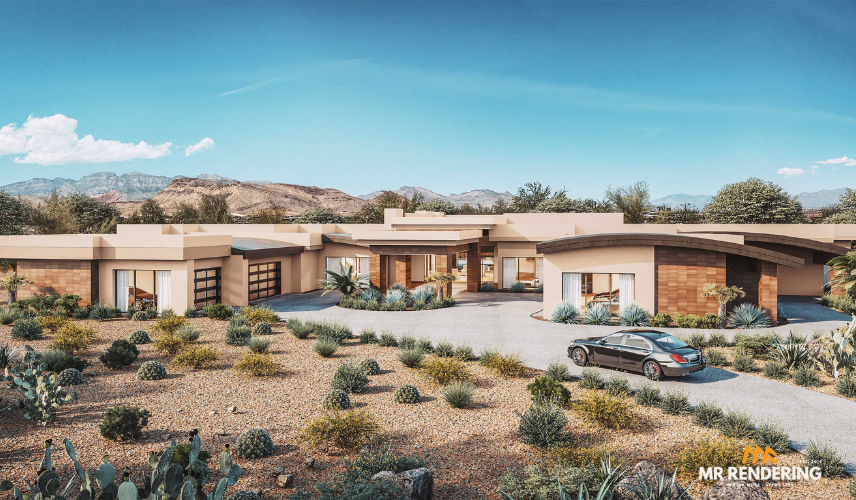
Aerial View of a Secluded Coastal Estate in Texas – Texas Project
Common Applications Driving Photomontage Demand
Planning applications represent perhaps the most critical use case for photomontage architecture. Regulatory authorities increasingly require Accurate Visual Representations (AVRs) that demonstrate precisely how proposed developments affect protected views, conservation areas, or sensitive heritage contexts. These verified photomontages must meet specific technical standards, often requiring third-party verification of camera positions and modeling accuracy.
Marketing and pre-sales campaigns for residential and commercial developments rely heavily on photomontages to overcome the credibility gap inherent in pure CGI. Prospective buyers make substantial financial commitments based on these visualizations, so seeing the exact neighborhood context—familiar streets, nearby amenities, and actual surroundings—builds confidence that abstract renderings cannot match.
Design competitions and proposal submissions use photomontages to communicate design intent compellingly. When competing firms present to selection committees, photomontages that show the proposed building in actual site context demonstrate thorough site analysis and create memorable, convincing presentations that abstract drawings cannot achieve.

Luxury Hillside Desert Modern Villa with Infinity Pool – Boston project | Read more about 3D Rendering service in USA here
The Future of Photomontage Technology
Emerging technologies continue advancing photomontage capabilities. Machine learning algorithms now assist with automatic sky extraction, perspective matching, and lighting analysis, accelerating workflow while maintaining quality. Real-time rendering engines enable interactive photomontage architecture where viewers can adjust sun position, season, or viewing angle dynamically. Augmented reality applications allow stakeholders to experience photomontages on-site, holding tablets or phones that overlay proposed designs directly onto live camera feeds of the actual location.
For architects and developers seeking to present projects with maximum credibility and impact, photomontage architecture remains an essential tool. The combination of photographic authenticity and 3D flexibility creates visualizations that resonate with diverse audiences—from technical planning committees to community members to potential investors. By investing in professional photomontage services, you ensure your designs are understood, appreciated, and approved in the contexts where they’ll actually be built.

Content Writer, Copy Writer
As a passionate content writer, Hoang Phuong specializes in creating high-quality, compelling narratives around 3D rendering and architectural visualization. Leveraging deep industry knowledge, Phuong excels at delivering information that is not only clear and creative but also genuinely inspiring, fostering stronger connections with clients and fellow professionals alike.

